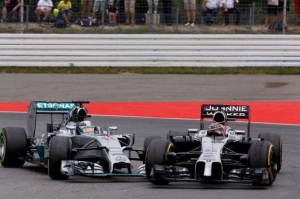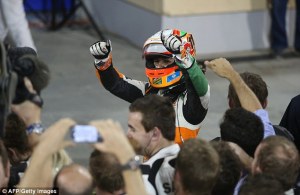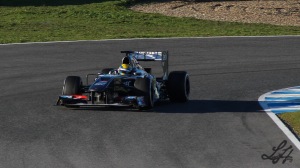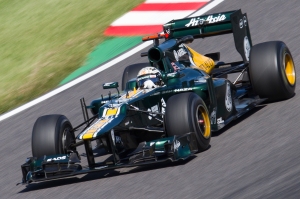Well, the German grand prix was certainly an exciting one, not that you would have noticed if you were Nico Rosberg. After suffering his first retirement of the season at Silverstone, the German bounced back at home to take what must rank as one of the most straightforward of his career.
Rosberg was aided by some misfortune for his Mercedes team-mate, Lewis Hamilton. This time trouble stuck for Hamilton during qualifying. His right front brake disk failed at 130 mph during Q1, pitching the Englishman’s Silver Arrow into a spin, and into the wall. Even though Hamilton’s time was good enough to get him through to the second part of qualifying, with his car in the wall and its driver out of the cockpit there was no opportunity for Hamilton to challenge for a higher grid slot.
It looked like a 15th place start for the 2008 world drivers’ champion, thanks to a three place penalty for Esteban Gutierrez, while Rosberg claimed pole position ahead of Valtteri Bottas and Felipe Massa in the Williams cars. As it turned out, though, the damage sustained when Hamilton hit the wall meant that his Mercedes team were forced to change his gearbox. The resulting five place grid penalty meant that Hamilton started in 20th.
Going in to the race everything pointed to a Rosberg win, and so it turned out. Rosberg got away cleanly at the start and was well ahead of the carnage caused when Kevin Magnussen’s McLaren came together with Massa’s Williams at turn one, pitching the latter into a roll and out of the race. Out came the safety car, but that made no difference to Rosberg, who again streaked clear at the restart.
Although he’d made up places at the original start, Hamilton was still only 17th when the safety car came in, with lots of work ahead of him to claw his way up to the sharp end of the field. By lap 10 Hamilton was up into the points in 10th place, while his team-mate was leading comfortably at the front. Hamilton was slicing his way through the field and was even up to second at one point before making his first pit stop on lap 27, running longer than his competitors having started on the slower prime tyres.
Hamilton fitted primes again at his pit stop and looked set to do a two stop race. As his team told him on the radio, Hamilton was looking good for a second place finish. That was until lap 30. Just a few laps after his pit-stop Hamilton came up behind Jenson Button’s McLaren. As Button went wide into the hairpin it looked for all the world that he had opened the door to let his former team-mate through. It certainly looked that way to Hamilton as he made his move down the inside of the McLaren, but Button cut back across Hamilton damaging the front wing of the Mercedes.
The damage had an impact on the handling of Hamilton’s car, increasing his tyre wear and forcing him to switch strategies to a three stop, running the options in the last two stints. Hamilton stopped for the second time on lap 44 meaning that Mercedes aimed to do two 13 lap stints on option tyres in the latter stages of the race. Amazingly, such was Hamilton’s speed, even with the damage to his front wing, that second place was still a very real possibility.
Then came another piece of bad luck for the Englishman. Sauber’s Adrian Sutil spun at the final corner and then stalled his car. The stricken Sauber was left in the middle of the track and it looked like the safety car would be deployed. That’s certainly what Mercedes thought as they pitted Hamilton the very next lap, even though it was five laps earlier than they had been aiming for. Had the safety car been deployed it would have been a potentially race winning strategy call. Hamilton emerged from the pits in fourth place and on fresh option tyres. With a bunched up field, with his competitors all on used tyres Hamilton would have been in a brilliant position to challenge his team-mate, who had led every lap of the race.
Unfortunately for Hamilton, the safety car wasn’t deployed. Despite the dangerous position of Sutil’s Sauber race control decided that it was fine to allow marshals onto the track to push the stricken car out of the way. That meant that Hamilton had to run on his last set of tyres for far longer than expected. In the end it cost Hamilton at least second place. Although he was able to pass Fernando Alonso in the Ferrari very easily and close on Bottas rapidly, by the time that he caught the Williams his tyres were finished and he was unable to pass.
Third was the best that Hamilton could manage in the end, while Rosberg, barely featuring on the TV coverage, cruised to victory some 20 seconds clear. Hamilton looked downcast after the race, despite his stunning drive from 20th to a podium. Luck certainly wasn’t on his side in Germany, but he should console himself with the thought that going in to Silverstone the points gap to his team-mate was some 29 points. It’s now just 14. Had Hamilton won in both Silverstone and Germany, with Rosberg second, the gap would have been 15 points.
The championship is far from over and if Hamilton can win in a week’s time in Hungary – as he did last year – things will be nicely set up going in to the mid-season break.

















